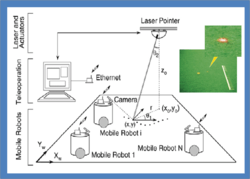Laser guidance

Laser guidance directs a robotic system to a target position by means of a laser beam. The laser guidance of a robot is accomplished by projecting a laser light, image processing and communication to improve the accuracy of guidance. The key idea is to show goal positions to the robot by laser light projection instead of communicating them numerically. This intuitive interface simplifies directing the robot while the visual feedback improves the positioning accuracy and allows for implicit localization. The guidance system serves also as a mediator for cooperative multiple robots.[1][2] Examples of proof-of-concept experiments of directing a robot by a laser pointer are shown on video.[3][4] Laser guidance spans areas of robotics, computer vision, user interface, video games, communication and smart home technologies.
Commercial systems
Samsung Electronics Co., Ltd. may have been using this technology in PowerBot robotic vacuum cleaners equipped with Point Cleaning™ function since 2014.[5] Samsung has shown its strong interest in bringing this product to the U.S. market by registering a trademark "Point Cleaning" with the United States Patent and Trademark Office (USPTO) on March 5, 2015 (serial No. 86555014). According to Samsung.com, PowerBot VR9000 with Point Cleaning™ can be purchased online in the USA in 2015. Powerbot robotic vacuums by Samsung have also been sold on Amazon.com since 2014.
Google Inc. applied for a patent with USPTO on using visual light or laser beam between devices to represent connections and interactions between them (Appl. No. 13/659,493, Pub. No. 2014/0363168).[6] However, no patent was granted to Google on this application.
Military use
Laser guidance is used by military to guide a missile or other projectile or vehicle to a target by means of a laser beam (Lidar), e.g. beam riding guidance or semi-active radar homing (SARH).[7] This technique is sometimes called SALH, for Semi-Active Laser Homing. With this technique, a laser is kept pointed at the target and the laser radiation bounces off the target and is scattered in all directions (this is known as “painting the target”, or “laser painting”). The missile, bomb, etc. is launched or dropped somewhere near the target. When it is close enough for some of the reflected laser energy from the target to reach it, a laser seeker detects which direction this energy is coming from and adjusts the projectile trajectory towards the source. While the projectile is in the general area and the laser is kept aimed at the target, the projectile should be guided accurately to the target. Note that laser guidance is not useful against targets that do not reflect much laser energy, including those coated in special paint which absorbs laser energy. This is likely to be widely used by advanced military vehicles in order to make it harder to use laser designators against them and harder to hit them with laser-guided munitions. An obvious circumvention would be to merely aim the laser closer to the target. Countermeasures to laser guidance are Laser detection systems, Smoke screen, anti-laser active protection systems.
See also
References
- ↑ Paromtchik, Igor (2006). "Optical Guidance Method for Robots Capable of Vision and Communication" (PDF). Robotics and Autonomous Systems. Elsevier. 54 (6): 461–471. doi:10.1016/j.robot.2006.02.005.
- ↑ "Method and System of Optical Guidance of Mobile Body". U.S. Patent 6,629,028.
- ↑ "Mobile Robot Guidance by Laser Pointer" (Video). Retrieved 3 May 2015.
- ↑ "Legged Robot Direction by Laser Pointer" (Video). Retrieved 3 May 2015.
- ↑ "Samsung's Robotic Vacuum Cleaner Chases Laser Pointer". 7 August 2014. Retrieved 3 May 2015.
- ↑ Purcher, Jack (14 December 2014). "Google Invents a Smartphone that Could Transfer Data to a Large Smart Wall or Display using a built-in Laser Beam". Retrieved 3 May 2015.
- ↑ "Spot Leading Target Laser Guidance for Engaging Moving Targets". U.S. Patent 8,237,095.
